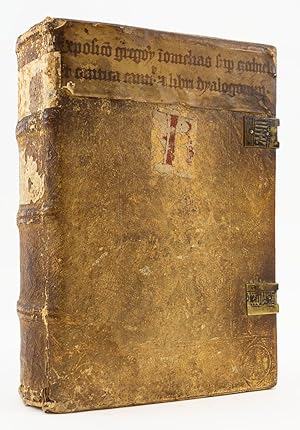Riguardo questo articolo
225 x 151 mm. (8 3/4 x 6"). Complete. [102] leaves; [22] leaves; [58] leaves; [42] leaves (last two blank). Double column, 47 lines in gothic type. Contemporary German blind-stamped pigskin, covers with frames and central panel decorated with lily stamp (Kyriss I, Plate 7, Fig. 2), corner with square stamp containing a rose (Kyriss I, Plate 7, Fig. 5), upper cover with early vellum label lettered ink and remnants of paper label with red ink initial K or R?), head of lower cover with two holes and dark shadow from iron eyelet used to chain the book in a library, raised bands, remnants of two old paper labels to spine panels, two brass clasps, remnants of vellum manuscript antiphonary leaves visible at hinges, pastedowns of roughly contemporary paper manuscript leaves with writing in a documentary hand. Attractively rubricated in red, capitals struck with red, a couple of six- to eight-line initials in red and blue at the beginning of each work, numerous four-line initials in red or blue. A2r with "Convent(us) Banbergensis ord. praed." written in ink at head of page (see below). Goff G 425; BMC III, 784; ISTC ig00425000; Goff G 395; BMC III, 783; ISTC ig00395000; Goff G 407; BMC III, 784; ISTC ig00407000; Goff G 441; BMC III, 783; ISTC ig00441000. â Pigskin a bit soiled and rubbed, quarter-inch chip across foot of spine showing stitching underneath, pastedowns with three or four short worm trails, first five leaves with (diminishing) wormhole in tail margin, one leaf with two-inch closed tear into text (no loss), isolated thumbing and other trivial imperfections, but A VERY PLEASING COPY--clean, fresh, and bright internally, in a completely solid unrestored period binding with considerable antique appeal. This is a collection of short tracts by Pope Gregory I in a very appealing contemporary binding from the library of a culturally influential Benedictine monastery in Bamberg--as indicated by the inscription at the opening of the text and by the stamps in the pigskin, which Kyriss attributes to the monastery's bindery. The pope, better known as St. Gregory the Great (ca. 540-604), is one of the Latin Fathers and a Doctor of the Church, so widely admired as a theologian that even Protestant reformer John Calvin held him in high esteem. Among other accomplishments, he sent missionaries headed by Augustine of Canterbury to bring the pagan Anglo-Saxons into the Catholic faith, reworked the Divine Liturgy, instituted the plain chant that bears his name, and wrote prolifically in helping to establish the foundation of the Medieval papacy and of Medieval spirituality. Two of his best-known works are included here: the "Dialogues," which recount the miracles and other acts of early Italian Christians (including St. Benedict), and the "Pastorales," discussing the role of bishops in the church. The other two works here are sermons on the book of Ezekiel, and commentary on the Song of Songs. BMC notes that Furter printed these editions within a relatively short period--"Song of Songs" is dated 13 March 1496 and "Pastorales" 15 February 1496--apparently intending to sell them both separately and as a set. Michael Furter (d. ca. 1516-17) operated a press in Basel from 1489 into the second decade of the 16th century. Kyriss identifies the stamps used on our binding as those of the Benedictine abbey of St. Michael (Kloster Michaelsberg) in Bamberg in Bavaria. According to EBDB, its bindery was active from 1474-1515. The name of one of the bookbinders, Brother Fridericus Neupauer, is known from written records. The abbey was founded by the bishop of Bamberg in 1015, and richly endowed. Its scriptorium was especially renowned in the Middle Ages; it is possible the especially attractive--and thorough--rubrication of this tome was done by the monks there. Third Edition of the first work; Second Edition of the second work; 11th Edition of the third work; Eighth Edition of the last work.
Codice articolo ST19369
Contatta il venditore
Segnala questo articolo




